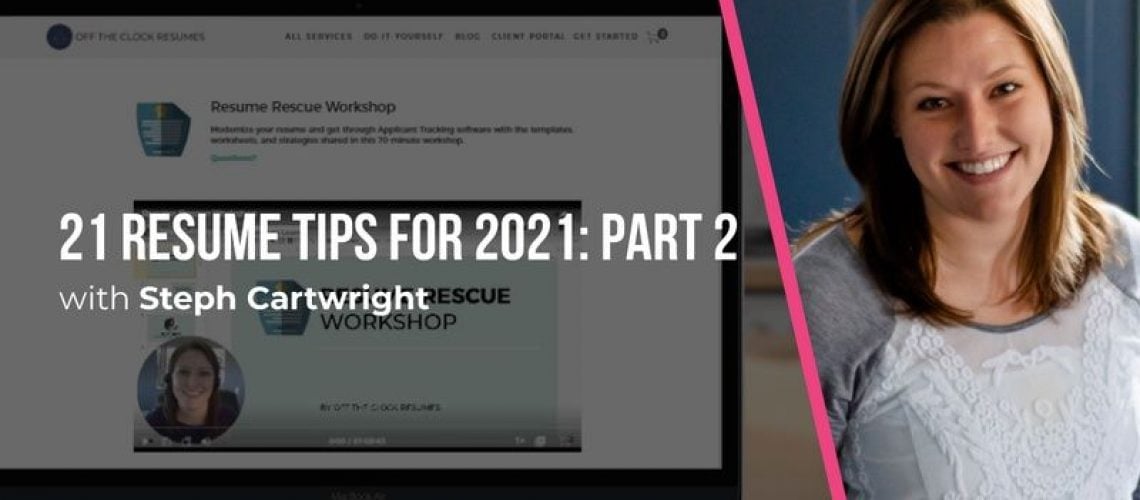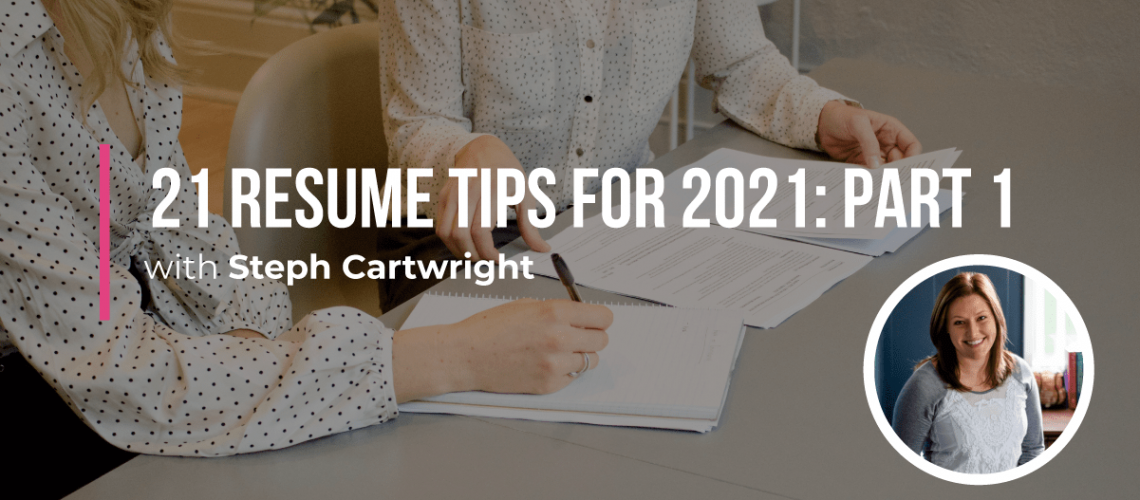Resume writing is often the most dreaded task for job seekers because either:
- You have a difficult time talking about yourself in a resume,
- You have a hard time quantifying skill sets, and your edu-crastination (You like that?) has only instilled in you that quantifying your skills is the only way to get an interview,
- You have no idea what to do with your overly diversified experience or work history timeline issues like multiple company acquisitions, demotions, or changing job titles; or
- You’re just too exhausted to work on your resume after work.
No matter what your reason is, I'm here to help. I've assembled my top resume tips for 2021 to guide you through, updating, revamping, and ultimately crafting a job-winning resume that gets you hired faster. In Part 1 of this 2021 resume guide , I outlined how to design and position yourself as the best fit for the job that you want. Let's chat about how to craft different sections of your resume and capture the attention of recruiters, HR professionals, and hiring managers in all the right ways to get you more interviews.
11 | Introduce Yourself With A Branding Statement
Speaking of outdated Objective Statements and boring Resume Summaries, your resume is not about you. Yes, you read that right. Get rid of that self-serving introduction that is frankly wasting valuable real estate. Once your resume gets in front of a human reader, the top third of your resume is the first (and often the only) section that will be read, so make it count!
Encourage the reader to get to know you more by creating a Branding Statement that doesn’t just introduce your qualifications or highlight your top job-related skills but really showcases the unique value you offer or the results you will produce for the employer in a short paragraph (no more than 4-6 lines).
Find Your Next Job
Looking for a career move? Use these resume tips and apply for your next energy job today.
Apply Today
12 | Make Your Experience Section Easy To Skim
Nearly every resume I’ve seen, prior to working with the job seeker, suffers from one of these three crippling afflictions:
- Long blocks of text with no bullets which forces the reader to read every line of the resume in order to find the details they’re looking for (qualifications, skills, achievements, etc.)
- Too many bullets which also forces the reader to read every line of the resume to find the details they’re looking for (qualifications, skills, achievements, etc.)
- Not enough information to determine if you’re the best fit for the job or not
If your resume suffers from either of the first two afflictions, I have bad news for you.
Corporate recruiters, HR professionals, and hiring managers are not going to spend the time reading each and every line of your resume before deciding whether or not you’re going to move forward in the hiring process. If your resume takes more than 6 seconds to skim, it will likely be tossed.
Make your Experience section easy to skim by alternating between short paragraph summaries and bullet lists that draw attention to your achievements, major contributions, or top skills in action.
13 | Add Keywords To Your Job Summaries
Your resume needs to tell employers that you are the best fit for the job. If your resume doesn’t have enough information to achieve this, here’s a quick and easy fix for you. Describe the typical tasks and responsibilities you held that relate to the job you’re applying for. This is particularly successful for job seekers targeting higher-level positions or changing careers entirely.
Better yet, optimize your job summaries by adding in the keywords found in the job posting. This will greatly improve your ranking when your resume is battling Applicant Tracking systems and show employers that you’re paying attention to their terminology.
14 | Follow This Resume Storytelling Framework
Don’t just say you have excellent project management skills or that you’ve managed projects. In writing classes, you’ll frequently hear the phrase, “Show, don’t tell.” This concept is especially true for writing a great resume. Don’t just claim you have certain skills and abilities, but tell your unique story of how you made a difference by applying those skills and abilities in the workplace.
Your resume should highlight how you demonstrated certain skills and what resulted in a fair amount of context. The storytelling framework that corporate recruiters and hiring managers love to see looks something like this:
Results or what you achieved + compared to before or why your efforts were necessary + the actions you took or skill(s) you applied
15 | Don’t Hide Your Resilience During The Pandemic
So many people have been impacted by the spread of COVID-19 in 2020. Whether you lost your job, started working from home for the first time in your career, or juggled work and at-home schooling for your children, you had to pivot and make changes to your daily routines. Amplify your resume with these transferable skills!
Own your employment gaps by filling the space in your Experience section with the volunteer experience, continued education, professional development, or at-home experiences that demonstrate:
- Leadership Development
- Skills Development
- Flexibility/Adaptability
- Change Management
- Process Improvement
If you were fortunate enough to not be furloughed or laid off, make sure to update your Experience section with examples of how you’ve led or influenced change that enabled you to continue driving business or serving your customers.
16 | Showcase Your Achievements & Major Contributions
If you think a flashy graphic resume design is what you need to stand out, you’re not thinking like an employer. Measurable achievements—or achievements that you can quantify—matter more than anything else on your resume! The measurable achievements you have made are unique to you and play a key role in presenting the unique value you offer to employers.
Don’t get caught up in thinking, “I’m not in sales, so I can’t come up with any measurable achievements.” Describing the results of any major contribution that you made toward achieving company or department goals constitutes an achievement even if quantifying it might be a bit more difficult.
17 | Streamline Your Work History Timeline
Applicant Tracking systems and HR teams want to see a clear, consistent work history timeline. HR teams are often more forgiving, but getting past ATS is still your first challenge. This may mean adjusting the timeline you’re listing on your resume, and I’m not talking about changing dates or lying.
You can also downplay gaps in employment by listing only your last so-many years of uninterrupted work history and summarizing your previous experience without dates in a short Additional Experience note at the end of your Experience section. Streamlining your work history timeline may also mean removing shorter-term and less relevant positions to eliminate the appearance of “job-hopping.”
Your resume should be a snapshot of your most relevant skills and experience, not an autobiography.
18 | Keep Interest On Your Qualifications, Not Your Age
I know I touched on this before by indicating that dates older than 2005 have no place on your resume (unless indicated for an executive-level role), but there are other details on your resume that may be drawing more attention to your age than your qualifications.
- Unless you are a high school student, remove your high school & graduation date.
- Unless you graduated within the last five years, remove college graduation dates.
- If you have an aol.com or yahoo.com email address, consider creating a free Gmail or Outlook account.
- Remove outdated software skills (or software versions for you, IT job seekers!)
If you’re questioning why age is such a turn-off to employers, think about it from their perspective. Drawing attention to 20+ years of experience can also imply that you desire a higher salary than another qualified candidate listing fewer years of experience. Even if you’re experience doesn’t imply a desired-salary outside of their budget, a clearly younger candidate may be a safer bet when it comes to training and culture fit.
19 | Trim Down Your Education Section
Why certain industries (like technology) require college degrees still baffles me! Much of the information learned in college will be obsolete in 5-10 years, but it’s still a prominent qualification that gives many job seekers anxiety. There are still a vast number of employers who value experience over higher education, and your Education section may actually be hindering you from landing the jobs you want.
If you’re applying for a job requiring a bachelor’s degree but you’re listing your advanced degrees (e.g. masters or doctorate), you may be presenting yourself as overqualified or too expensive. Your advanced degree is a HUGE accomplishment, but you need to be targeting your Education section to reflect the desires of the company.
Missing a required or preferred college degree? Using LinkedIn for personal branding, networking, and employer targeting can help you get your foot in the door and bypass ATS altogether!
Get more career advice with Stefano Mazzoni's "Top 10 Job-hunting and Networking Tips".
Read Here
20 | Proofread & Edit For Human Readers
Job seekers often fall into a trap when they spend hours researching how to write a resume that gets through ATS. They get a little keyword-crazy and even start copying-and-pasting general statements from job postings directly into their resume.
Fortunately for you, Applicant Tracking systems are getting smarter. Most modern ATS has evolved to search for messages rather than keywords. You now have the freedom to tell your unique story without having to use the words and phrases verbatim from the job posting.
Once you’ve finished writing your resume, read through and proofread it for human readability. Does it sound like a robot wrote it, or does it sound like your unique story?
21 | Update Your Resume Regularly
How often do you update your resume? Let me guess… once a year or every few years when you hear about a great job opportunity. That’s usually when my clients come back to me looking to update their resumes!
Don’t put unnecessary stress on yourself. Start keeping a list of any projects (large or small) or contributions made toward achieving company goals every month. Every six months, update your resume to reflect changing responsibilities or achievements. When you complete on-the-job training or online courses to keep your skills fresh, add it to your resume.
The key is to always be prepared to apply for a new and better job when it presents itself instead of scrambling to make a great first impression.
Conclusion
Resume writing is a balancing act, and your resume has to be written for three audiences: Applicant Tracking systems, HR, and a direct supervisor or hiring manager deciding who will get the interview. Writing a great resume means telling your unique career story while naturally integrating the keywords ATS will be looking for to rank you against other applicants.
If your resume isn’t landing you many interviews, use this list of resume tips for 2021 to refresh your resume and start positioning yourself as the best fit for the job that you want.





